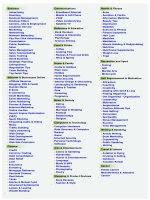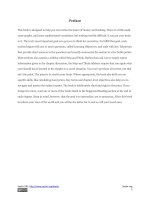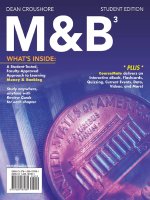Money and Banking: Lecture 32
Bạn đang xem bản rút gọn của tài liệu. Xem và tải ngay bản đầy đủ của tài liệu tại đây (471.58 KB, 29 trang )
Money and
Banking
Lecture 32
McGrawHill/Irwin
Copyright © 2006 by The McGrawHill Companies, Inc. All rights reserved.
Review of the Previous Lecture
• Central Bank
• Roles
• Government’s Bank
• Bankers’ Bank
• Objectives
•
•
•
•
•
Low, Stable Inflation
High, Stable, Growth
Stable Financial System
Interest rate stability
Exchange rate stability
17-2
Meeting the Challenge: Creating a
Successful Central Bank
•
•
The boom in the past decade with its
associated decrease in volatility may
have happened because technology
sparked a boom just as central banks
became better at their jobs.
Policymakers realized that sustainable
growth had gone up, so interest rates
could be kept low without worrying about
inflation, and central banks were
redesigned.
17-3
• Today there is a clear consensus about
the best way to design a central bank and
what to tell policymakers to do.
• A central bank must be
•
•
•
•
independent of political pressure,
accountable to the public,
transparent in its policy actions,
clear in its communications with financial
markets and the public.
17-4
• In addition, there is general agreement
• that policy decisions are better made by
committee than by individuals,
• that everyone is well served when
policymakers operate within an explicit
framework that clearly states their goals and
the tradeoffs among them.
17-5
The Need for Independence
• The idea that central banks should be
independent of political pressure is a new
one, because central banks originated as
the governments’ banks.
• Independence has two components:
• Monetary policymakers must be free to control
their own budgets
• The bank’s policies must not be reversible by
people outside the central bank.
17-6
• Successful monetary policy requires a
long time horizon, which is inconsistent
with the need of politicians to focus on
short-term goals.
• Given a choice, most politicians will
choose monetary policies that are too
accommodative, keeping interest rates low
and money growth rates high.
• While this raises output and employment
in the near term it may result in inflation
over the longer term.
17-7
•
To insulate policymakers from the daily
pressures faced by politicians,
governments have given central banks
control of their own budgets, authority to
make irreversible decisions, and
appointed them to long terms.
17-8
Decision-Making by Committee
• In the course of normal operations, it is
better to rely on a committee than on an
individual.
• Pooling the knowledge, experience, and
opinions of a group of people reduces the
risk that policy will be dictated by an
individual’s quirks, not to mention that in a
democracy, vesting so much power in one
individual poses a legitimacy problem.
17-9
The Need for Accountability and
Transparency
• Central bank independence is inconsistent
with representative democracy.
• To solve this problem, politicians have
established a set of goals and require the
policymakers to report their progress in
pursuing these goals.
• Explicit goals foster accountability and
disclosure requirements create
transparency.
17-10
• The institutional means for assuring
accountability and transparency differ from
one country to the next;
• in some cases the government sets an explicit
numerical target for inflation, while in others
the central bank defines the target.
• Similar differences exist in the timing and
content of information made public by
central banks.
17-11
17-12
• Today it is understood that secrecy
damages both the policymakers and the
economies they are trying to manage, and
that policymakers need to be as clear as
possible about what they are trying to
achieve and how they are going to
achieve it.
17-13
The Policy Framework, Policy
Trade-offs, and Credibility
•
•
The monetary policy framework is made
up of the objectives of central banks and
the requirements that central banks be
independent, accountable, and good
communicators.
The monetary policy framework exists to
resolve the ambiguities that arise in the
course of the central bank’s work and
also clarifies the likely responses when
goals are in conflict with one another.
17-14
•
•
•
Central bankers face the tradeoff
between inflation and growth on a daily
basis.
Since policy goals often conflict, central
bankers must make their priorities clear.
A well-designed policy framework also
helps policymakers establish credibility.
17-15
The Principles of Central Bank Design
Independence To keep inflation low, monetary decisions
must be made free of political influence
Decision
making by
committee
Pooling the knowledge of a number of people
yields better decisions than decision making
by an individual
Accountability Policy makers must be held accountable to
and
the public they serve and clearly communicate
transparency their objectives, decisions and methods
Policy
framework
Politicians must clearly state their policy goals
and the tradeoffs among them
17-16
Fitting Everything Together: Central
Banks and Fiscal Policy
• The central bank does not control the
government’s budget; fiscal policy (the
decisions about taxes and spending) is
the responsibility of elected officials
• While fiscal and monetary policymakers
share the same ultimate goal of improving
the well-being of the population, conflicts
can arise between the two.
17-17
•
•
•
Funding needs create a natural conflict
between monetary and fiscal
policymakers.
Fiscal policymakers also tend to ignore
the long-term inflationary effects of their
actions.
Politicians often turn to borrowing
(instead of taxes) as a way to finance
some portion of their spending, but a
country can issue only so much debt.
17-18
• Inflation is a real temptation to
shortsighted fiscal policymakers because
it is a way to get money in their hands and
it’s a way for governments to default on a
portion of the debt they owe.
• Responsible fiscal policy is essential to the
success of monetary policy.
17-19
The Central Bank’s Balance
Sheet
•
•
The central bank engages in numerous
financial transactions, all of which cause
changes in its balance sheet.
Central banks publish their balance
sheets regularly. Publication is a crucial
part of transparency
17-20
The Central Bank’s Balance Sheet
17-21
Assets
•
The central bank’s balance sheet shows
three basic assets:
•
•
•
securities,
foreign exchange reserves,
loans.
17-22
• Securities:
• The primary assets of most central banks;
• Independent central banks determine the
quantity of securities that they purchase
• Foreign Exchange Reserves:
• The central bank’s and government’s
balances of foreign currency are held as
bonds issued by foreign governments.
• These reserves are used in foreign exchange
market interventions.
17-23
•
Loans are extended to commercial
banks, and can fall into two categories:
discount loans and float
•
•
Discount loans: the loans the central bank
makes when commercial banks need shortterm cash.
Float: a byproduct of the central bank’s
check-clearing business. The central bank
credits the reserve account of the bank
receiving the check before it debits the
account of the bank on which the check was
drawn and this creates float
17-24
• Through its holdings of Treasury securities
the central bank controls the discount rate
and the availability of money and credit.
• Gold reserves, while still an asset of many
central banks, are virtually irrelevant these
days.
17-25









